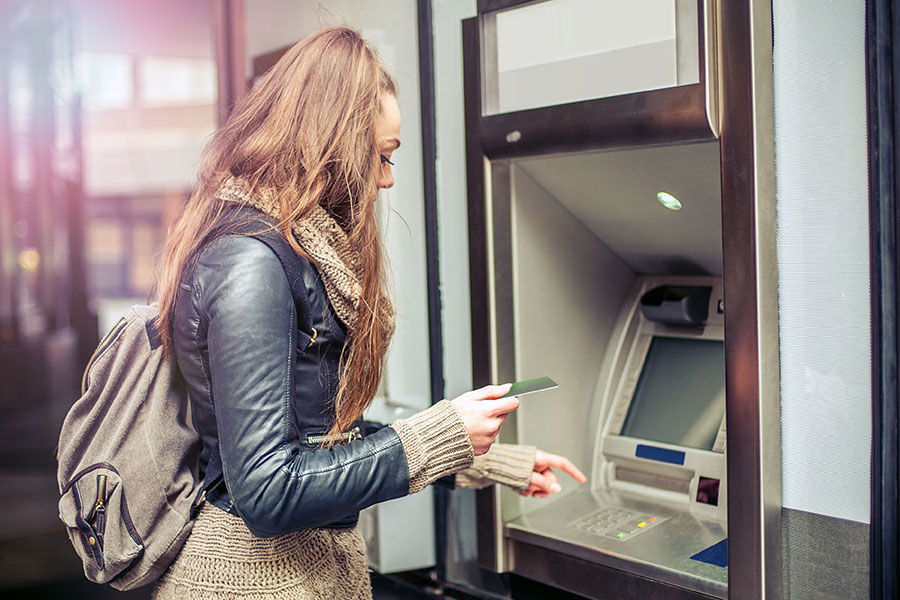Managing money in college is easier with the right checking account. The best student accounts have no monthly fees, no minimum balance requirements, and perks like early direct deposit or cashback rewards. Many also offer fee-free ATM access and tools to help students build good financial habits.
If you’re looking for a student-friendly bank account that won’t eat into your budget with fees, here are the top options for 2026.
11 Best Student Checking Accounts
Not surprisingly, many of the best student checking accounts come from banks that also offer some of the best checking accounts for any age. However, the products below – in most cases – are tailored for young adults from the ages of 18 to 24, with the features this age group desires most, including an intuitive mobile app and low or nonexistent minimum deposit requirements.
1. Best for Working Students: Chime®
Chime® isn’t a traditional bank, but a financial technology company backed by Stride Bank, N.A., and The Bancorp Bank.
2. Best for Mobile-First Budgeting: Current
Current is a mobile banking app designed for students who want a simple, fee-free way to manage money—and even build credit.
3. Best for Referrals to Earn Extra Cash: GO2bank
GO2bank, a digital bank backed by Green Dot, makes it easy for students to earn extra cash through its generous referral program.
4. Best for Students Under 18: Capital One MONEY Teen
Capital One MONEY Teen is a joint checking account designed for students ages 8 to 17, with a parent or legal guardian as a co-owner.
5. Best Account Opening Bonus: Chase College Checking
Chase College Checking is a great option for students looking to earn extra cash when opening an account.
6. Best for Comprehensive Money Management: PNC Virtual Wallet Student
PNC Virtual Wallet Student is designed to help students manage their money by separating funds into three categories: Spend (checking), Reserve (short-term savings), and Growth (long-term savings).
7. Best Credit Union: Alliant Credit Union Teen Checking
Alliant Credit Union Teen Checking is a great choice for students ages 13 to 17 who want a fee-free checking account with parental oversight.
8. Best for Yield: Ally Interest Checking
Ally Bank’s Interest Checking account isn’t designed specifically for students, but its combination of no fees and interest-earning checking makes it a great option.
9. Best for Full-Service Banking: Bank of America Advantage SafeBalance Banking
Bank of America Advantage SafeBalance Banking is a checkless account designed for students who want a full-service banking experience.
10. Best for Establishing Savings Habits: Wells Fargo Clear Access Banking
Wells Fargo Clear Access Banking is a straightforward checking account designed for students and young adults. It has no overdraft fees, making it a good choice for those still learning to manage their finances.
11. Best for Cash Back: Discover Cashback Debit
Discover Cashback Debit is a rare checking account that offers cash back on debit card purchases.

Methodology: How We Select the Best Student Checking Accounts
To find the best student checking accounts, we evaluated the monthly maintenance fees, ATM fees, minimum deposit requirements, features, benefits, banking services provided, along with customer service and mobile app access at several of the biggest and most well-known banks and credit unions.
ATM Network
Most banks have ATM networks or partner ATM networks of 20,000 or more ATMs nationwide where you can use your debit card with no ATM fees. You might be surprised to learn that even online banks and financial technology companies that are not a bank provide access to thousands of ATMs nationwide through partner programs.
Nationwide availability (physical locations or mobile access)
College students often split time between their college campus and the home where they grew up. Finding a bank with physical locations in the areas they live or an online bank that provides a mobile banking app with fee free mobile banking from anywhere is important.
Fees and minimum requirements
Bank fees no longer have to be a way of life for today’s young adults. We chose financial institutions with no monthly maintenance fees or easy ways to waive maintenance fees.
Benefits such as high APY, cash-back rewards, or other additional perks
Student checking accounts today are more than just “bare bones” places to store your cash. Many student bank accounts offer perks, benefits, and high-yield savings or an interest bearing checking account to provide added value.
Overdraft fees
Cash management mistakes happen, especially when young adults first start learning to budget and manage their finances. Many banks have no overdraft fees, and some offer overdraft protection to help out in a pinch.
How to Choose the Best Bank for College Students
We’ve offered 12 solid options to help you choose the best student checking account. Before you open a student bank account, it’s a good idea to think about what you need in your primary checking account and a linked savings.
The list below makes it easy to review your must-haves and nice-to-haves when you choose your first bank account as a college student.
- Best student checking account interest rates: If you’re looking to earn interest on your standard checking account, many banks offer this feature. Review annual percentage yield (APY) figures for your top choices. Remember, a higher savings interest rate might benefit you more, since money in your checking account tends to fluctuate based on paychecks, bills, and expenses. The best checking account may not pay interest, but can save you money in other ways.
- Annual percentage yield (APY): Likewise, you can put money in your pocket with an account with linked savings offering a high annual percentage yield (APY).
- Online and mobile banking: Look for a bank that offers robust online and mobile banking services. These platforms should allow you to manage your finances conveniently from your computer or smartphone. With features like mobile check deposit, you can easily and securely deposit checks by taking photos with your phone, making it a valuable tool for busy students.
- No monthly maintenance fees: Many banks today make it easy to find a free checking account with no maintenance fees. If you have to pay a monthly maintenance fee, find out exactly what you’re getting for your money. Find out if the perks and benefits, such as a cash back debit card or reimbursement of ATM fees, make the maintenance fees worthwhile.
- Minimum deposit and minimum balance requirements: When you’re just getting started, cash may be tight. It’s important to find an account with no minimum deposit to open.
- Banking services provided: Accounts should have customer service online, by phone or in branches, plus an easy-to-use mobile app and a debit card with no ATM fees.
Frequently Asked Questions
Read what people are asking about the best student checking accounts, including minimum deposit requirements and benefits of a student checking account.
What are the benefits of a student bank account?
A bank account tailored for students gives young adults a head start on their financial future and learning how to manage money. For students who work, they can receive direct deposits in their student account, pay bills online, and send money to friends and family using Zelle.
How to get a student checking account bonus?
Several student checking accounts, including Chase, provide sign-up bonuses. Make sure to read the fine print and complete the requirements, which may include setting up direct deposit or making a minimum opening deposit, to collect the bonus.
Can I open a student checking account without a deposit?
To open a student checking account without a minimum deposit requirement, simply look for a bank account, like Chime or Varo, that does not require one.
Are there any downsides to opening a student checking account?
When you open a student checking account, you’ll want to make sure you won’t pay monthly maintenance fees. Some student checking accounts convert to a regular account once the student graduates, and there may be fees associated with the regular account.
Is there an age limit on a student checking account?
Most student checking accounts are open to students from the age of 18 to 24 without a joint account holder. Customers under the age of 18 may be able to open an account with a joint owner.
See also: How Old Do You Have to Be to Open a Bank Account?
Can minors open student checking accounts?
Accounts like Capital One Money Teen are available to children ages 8 and up with a joint account holder. Some other accounts require students to be 18 or older.
What happens to your student checking account when you graduate?
Many of the student bank accounts on this list won’t change when you graduate college. Others offer the option to convert your account to one of the bank’s regular checking products. A Chase College Checking Account has no monthly fees for your first five years in college, but if you graduate or exceed that time frame, you might pay a $6 monthly maintenance fee unless you meet other requirements.















